Hirschsprung’s disease - Study guides, Class notes & Summaries
Looking for the best study guides, study notes and summaries about Hirschsprung’s disease? On this page you'll find 337 study documents about Hirschsprung’s disease.
Page 3 out of 337 results
Sort by
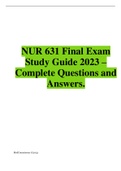
-
NUR 631 Final Exam Study Guide 2023 – Complete Questions and Answers | Latest Guide 2023
- Exam (elaborations) • 40 pages • 2023
-
- $13.99
- + learn more
NUR 631 Final Exam Study Guide 2023 – Complete Questions and Answers. Describe the type of lesions found in psoriasis & seborrheic and actinic keratosis. Elevated, firm, and rough lesion with flat top surface greater than 1 cm in diameter Describe the skin lesions found in Varicella (chickenpox) and herpes zoster (shingles). Elevated circumscribed, superficial lesion filled with serous fluid, less than 1 cm in diameter Describe the pathogenetic mechanism of polycystic ovarian syndrome (POS). P...
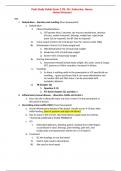
-
Peds Study Guide Exam 2 (GI, GU, Endocrine, Neuro, Heme/Immune)
- Exam (elaborations) • 34 pages • 2024
-
- $18.19
- + learn more
Kim 1. Dehydration – diarrhea and vomiting (from powerpoint) a. Dehydration i. Clinical Manifestations: 1. CRT greater than 3 seconds, dry mucous membranes, absence of tears, sunken fontanels, lethargy, weight loss, rapid weak pulse (1st to respond), low BP (last to respond) ii. Urine output needs to be 1mL/kg per hour for anyone under 30kg. iii. Dehydration Criteria (% of body weight lost) 1. Mild dehydration=5% of total body weight 2. Moderate=10% of total body weight 3. Severe...
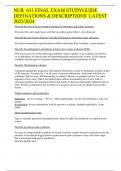
-
NUR 631 FINAL EXAM STUDYGUIDE DEFINATIONS & DESCRIPTIONS LATEST 2023/2024
- Exam (elaborations) • 16 pages • 2023
-
- $8.99
- + learn more
Describe the type of lesions found in psoriasis & seborrheic and actinic keratosis. Elevated, firm, and rough lesion with flat top surface greater than 1 cm in diameter Describe the skin lesions found in Varicella (chickenpox) and herpes zoster (shingles). Elevated circumscribed, superficial lesion filled with serous fluid, less than 1 cm in diameter Describe the pathogenetic mechanism of polycystic ovarian syndrome (POS). POS has at least two of the following conditions: oligo-ovulation...
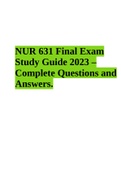
-
NUR 631 Final Exam Study Guide 2023 – Complete Questions and Answers.
- Exam (elaborations) • 28 pages • 2023
- Available in package deal
-
- $14.49
- + learn more
NUR 631 Final Exam Study Guide 2023 – Complete Questions and Answers. Describe the type of lesions found in psoriasis & seborrheic and actinic keratosis. Elevated, firm, and rough lesion with flat top surface greater than 1 cm in diameter Describe the skin lesions found in Varicella (chickenpox) and herpes zoster (shingles). Elevated circumscribed, superficial lesion filled with serous fluid, less than 1 cm in diameter Describe the pathogenetic mechanism of polycystic ovarian syndrome (...
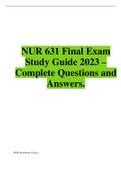
-
NUR 631 Final Exam Study Guide 2023 – Complete Questions and Answers | Latest Guide 2023
- Exam (elaborations) • 40 pages • 2023
-
- $15.99
- + learn more
NUR 631 Final Exam Study Guide 2023 – Complete Questions and Answers. Describe the type of lesions found in psoriasis & seborrheic and actinic keratosis. Elevated, firm, and rough lesion with flat top surface greater than 1 cm in diameter Describe the skin lesions found in Varicella (chickenpox) and herpes zoster (shingles). Elevated circumscribed, superficial lesion filled with serous fluid, less than 1 cm in diameter Describe the pathogenetic mechanism of polycystic ovarian syndrome (POS). P...

-
ATI_peds_questions and answers
- Exam (elaborations) • 24 pages • 2023
- Available in package deal
-
- $18.49
- + learn more
a nurse is planning care for a child who has severe diarrhea. which of the following actions is the nurse priority? A. Introduce a regular diet B. Rehydrate C. Maintain fluid therapy D. Assess fluid balance (Assess first the other three are interventions, before u intervene you have to assess how much fluid imbalance. Check for labs results because it will tell you what kind of fluid is to be given and how much fluid to be replaced. Priority is assessment first) A nurse is caring for a t...
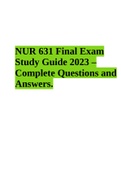
-
NUR 631 Final Exam Study Guide 2023 – Complete Questions and Answers.
- Exam (elaborations) • 28 pages • 2023
- Available in package deal
-
- $12.99
- + learn more
NUR 631 Final Exam Study Guide 2023 – Complete Questions and Answers. Describe the pathogenetic mechanism of polycystic ovarian syndrome (POS). POS has at least two of the following conditions: oligo-ovulation or anovulation, elevated lev- els of androgens, or clinical signs of hyperandrogenism and polycystic ovaries. Of the options available, only this answer accurately defines the pathogenetic mechanisms of POS. Describe Hirschsprung’s disease. Congenital aganglionic megacolon. Mech...

-
ATI NURSING : ATI Pediatric Test Bank 2, latest2021-2022 Complete answers PROCTORED
- Exam (elaborations) • 40 pages • 2024
- Available in package deal
-
- $13.99
- + learn more
ATI NURSING : ATI Pediatric Test Bank 2, latest Complete answers PROCTORED S - The Marketplace to Buy and Sell your Study Material a nurse is planning to care for a child who has severe diarrhea. Which of the following actions is the nurse's priority? A. Introduce a regular diet B. Rehydrate C. Maintain fluid therapy D. Assess fluid balance (Assess first the other three are interventions, before you intervene you have to assess how much fluid imbalance. Check for lab results because it wil...
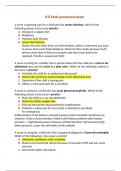
-
ATI Peds proctored exam
- Exam (elaborations) • 24 pages • 2023
- Available in package deal
-
- $18.49
- + learn more
a nurse is planning care for a child who has severe diarrhea. which of the following actions is the nurse priority? A. Introduce a regular diet B. Rehydrate C. Maintain fluid therapy D. Assess fluid balance (Assess first the other three are interventions, before u intervene you have to assess how much fluid imbalance. Check for labs results because it will tell you what kind of fluid is to be given and how much fluid to be replaced. Priority is assessment first) A nurse is caring for a t...
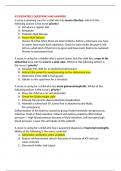
-
ATI PEDIATRICS QUESTIONS AND ANSWERS
- Exam (elaborations) • 24 pages • 2023
-
- $9.99
- + learn more
ATI PEDIATRICS QUESTIONS AND ANSWERS a nurse is planning care for a child who has severe diarrhea. which of the following actions is the nurse priority? A. Introduce a regular diet B. Rehydrate C. Maintain fluid therapy D. Assess fluid balance (Assess first the other three are interventions, before u intervene you have to assess how much fluid imbalance. Check for labs results because it will tell you what kind of fluid is to be given and how much fluid to be replaced. Priority is assessme...

How much did you already spend on Stuvia? Imagine there are plenty more of you out there paying for study notes, but this time YOU are the seller. Ka-ching! Discover all about earning on Stuvia


